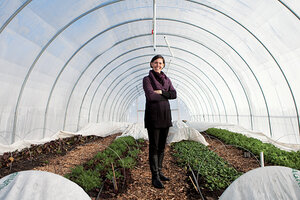Cities create 'food czars': Can they get residents to eat their sprouts?
A handful of cities are targeting obesity and hunger by putting a 'food czar' in charge of food-related policy – from getting greens in local markets to coordinating inner city microfarms.

Baltimore food czar Holly Freishtat visited the nonprofit Real Food Farm on Jan. 12. She sees the site as a model for urban agriculture, and is now eyeing 35 acres of city land for similar healthy-food projects.
Michael Bonfigli/Special to The Christian Science Monitor
Baltimore
What do a lawyer, an urban planner, and a chef have in common?
One of each is now a "food czar" – also known as a food-policy director – for a major US city.
A half-dozen big cities have recently installed food czars, whose responsibility is to improve residents' access to healthy, affordable food. This is one of the latest attempts to address both hunger and obesity, as well as related health issues.
New York Mayor Michael Bloomberg, among other mayors, has backed the food-czar approach. It's an outgrowth of food-policy councils, which have worked on myriad food-related issues. The hope behind food czars is that a sole paid staff person can function more nimbly than the bureaucracy of a larger council.
It's not a fluke that food czars come from varied backgrounds. In their new role, they need to draw on a multitude of skills, and they need to work effectively with a mix of organizations, from city agencies to food banks to supermarkets. "It's brilliant to have someone who is the architect of bringing all these folks together," says Deborah Flateman, chief executive officer of the Maryland Food Bank in Baltimore.
San Francisco was the first major US city to welcome a food czar, in 2002. Now Baltimore, New York, Boston, and Los Angeles have them as well.
They face a daunting task: In 2009, more than 17 million families went hungry in America, according to the US Department of Agriculture. Thirty-four percent of adults and 17 percent of children are obese, according to the latest data from the Centers for Disease Control and Prevention.
For cities, one particular problem is "food deserts" – low-income areas where the prevalent food options are chips and soda at corner stores instead of leafy green vegetables at supermarkets.
The food-czar positions to address these issues are "embryonic," says Gus Schumacher, vice president of policy at Wholesome Wave, a Connecticut nonprofit that convened the first-ever meeting of food czars last November in New York. "The fact that there is such enthusiasm bodes well, but these cities are on tight budgets."
Only two food czars are full-time employees of the cities they serve, and the rest are funded through short-term grants. None has an independent budget.
In Baltimore, Holly Freishtat came on board as food-policy director last April.
"There's no department of food," she says, explaining that her position fills a void in city government. "Whether it's a transportation or public-health or planning issue, it's really looking at a systemwide approach to food access."
One idea that Baltimore is pioneering is "virtual supermarkets." On a cold and sunny day last month, Ms. Freishtat visited such a project at the Orleans Street branch of the public library. There, an official from the city's Health Department helped an unemployed mother of two order groceries online from Santoni's Super Market, a longtime Baltimore grocer.
"At Santoni's, you have better quality meats, and the vegetables last longer," says the mother, Crystal Dixon.
To reach a supermarket, Ms. Dixon has to take a subway across town. It's easier to do her shopping at the library, she says.
The day after customers place their orders, Santoni's delivers the products to the library and swipes their EBT, or electronic benefit transfer, cards (which is an updated food-stamp system).
Three miles north of the library, Freishtat made a second stop: at Real Food Farm, which she sees as a model for urban agriculture. During the winter, the farm is using greenhouses to grow carrots, kale, and other vegetables. The six-acre site, which also includes a fruit orchard and fields for crops like squash, is run by a local nonprofit and supplies restaurants, a hospital, and neighborhood markets.
Freishtat has identified 35 city-owned acres suitable for similar projects. She plans to begin the leasing process this month with farmers and farm groups.
Will 35 acres feed a city with more than half a million residents? "No, that's not the intent," says Freishtat. "But will it affect the surrounding neighborhoods? Yes. It's just part of one of the larger strategies."
Indeed, many of the projects seem to only nibble at the problems.
"People have to be a little careful not to just jump on the trendy bandwagon that local food is the answer to serious structural food insecurity for 50 million Americans," says Joel Berg, executive director of the New York City Coalition Against Hunger, who nevertheless agrees that a food-policy position is vital for cities. He adds, "The question is how to turn the trendy interest into something serious and meaningful and concrete."
Some evidence is emerging that the work of food czars is beginning to have an impact. For example, a 2008 internal review of New York City's Office of the Food Policy Coordinator found that its efforts produced a 5 percent increase in subsidized meals for low-income students.
"There's a huge amount happening now in cities with food," says Nevin Cohen, assistant professor of environmental studies at The New School in New York. "Mayors are really beginning to realize it's a critical part of city government."
